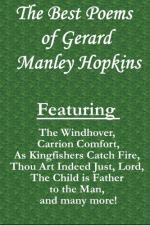
|
| Name: _________________________ | Period: ___________________ |
This test consists of 15 multiple choice questions and 5 short answer questions.
Multiple Choice Questions
1. Which word is enjambed at the end of line 1 and the beginning of line 2?
(a) Minion.
(b) Kingdom.
(c) Daylight.
(d) Morning.
2. Which techniques are evident in the phrase "dapple-dawn-drawn" (line 2)?
(a) Alliteration and internal rhyme.
(b) Onomatopoeia and metaphor.
(c) Metaphor and alliteration.
(d) Internal rhyme and onomatopoeia.
3. In lines 10 and 11, the speaker says that the fire "that breaks from thee" is a billion times "lovelier" and more what?
(a) Rapturous.
(b) Sanctified.
(c) Dangerous.
(d) Hypnotic.
4. What does "shéer plód" mean (line 12)?
(a) Keen and attentive determination.
(b) Slow, boring, repetitive work.
(c) Clumsy and random movement.
(d) A heavy feeling of apathy.
5. What would it mean to have "Rebuffed the big wind" (line 7)?
(a) To have abruptly and rudely responded to it.
(b) To have used rapid movements to shine or polish it.
(c) To have brushed against its force and been knocked back.
(d) To have stood up to and turned away its advance.
6. What type of rhyme is seen in the poem's "B" lines"?
(a) Feminine.
(b) Masculine.
(c) Eye.
(d) Slant.
7. What does the word "wimpling" literally mean in the context of line 4?
(a) Covering.
(b) Muffling.
(c) Rippling.
(d) Like a nun's habit.
8. What type of rhyme is seen in the poem's "A" lines?
(a) Feminine.
(b) Slant.
(c) Eye.
(d) Masculine.
9. Who is being referred to in line 10's "thee"?
(a) The speaker.
(b) The windhover.
(c) Christ.
(d) The air.
10. What techniques are evident in the phrase "Rebuffed the big wind" (line 7)?
(a) Assonance and euphony.
(b) Euphony and personification.
(c) Consonance and assonance.
(d) Personification and consonance.
11. What does line 10 say "Brute beauty and valour and act, oh, air, pride, plume" do "here" (line 9)?
(a) Break.
(b) Stir.
(c) Buckle.
(d) Soar.
12. What technique is employed in the line 9 phrase "oh, air, pride, plume, here"?
(a) Antithesis.
(b) Anaphora.
(c) Atanaclasis.
(d) Asyndeton.
13. In lines 5 and 6, what is the bird's motion compared to?
(a) An arrow.
(b) A ball being thrown.
(c) A swing.
(d) An ice skater.
14. What is the common name of the titular bird?
(a) Kestrel.
(b) Kite.
(c) Osprey.
(d) Hawk.
15. What is a "chevalier" (line 11)?
(a) A horse.
(b) A bird.
(c) A knight.
(d) A falconer.
Short Answer Questions
1. Between which lines does the poem use "light rhyme"?
2. What device is evident in line 10's "the fire that breaks from thee then"?
3. To whom is the poem dedicated?
4. What is "sillion" (line 12)?
5. In line 5, what does the speaker claim the bird is feeling?
|
This section contains 401 words (approx. 2 pages at 300 words per page) |

|




